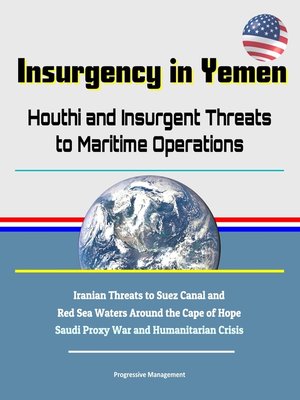Insurgency in Yemen
ebook ∣ Houthi and Insurgent Threats to Maritime Operations--Iranian Threats to Suez Canal and Red Sea Waters Around the Cape of Hope, Saudi Proxy War and Humanitarian Crisis

Sign up to save your library
With an OverDrive account, you can save your favorite libraries for at-a-glance information about availability. Find out more about OverDrive accounts.
Find this title in Libby, the library reading app by OverDrive.



Search for a digital library with this title
Title found at these libraries:
| Library Name | Distance |
|---|---|
| Loading... |
This excellent and interesting report has been professionally converted for accurate flowing-text e-book format reproduction. The world depends on the Suez Canal for ocean trade, and the United States maintains a presence in the Red Sea region to ensure open waters around the Cape of Hope. During Yemen's ongoing civil war, the Houthi movement has targeted the Saudi Arabia-led coalition, including U.S. Navy ships. This thesis explores whether the threat to the U.S. Navy and partners has increased and whether, as a result, CENTCOM's strategy needs to change to protect U.S. interests. The thesis examines U.S. grand strategy, CENTCOM strategy, the rise of the Houthi movement and its support from Iran, and the attacks on U.S. and partner ships. As the humanitarian crisis in Yemen worsens, this thesis finds that the maritime threat has also increased, creating a threat to both U.S. interests and global trade. U.S. leadership must consider a revised response.
This compilation includes a reproduction of the 2019 Worldwide Threat Assessment of the U.S. Intelligence Community.
I. Introduction * A. Major Research Question * B. Significance of the Research Question * C. Literature Review * D. Potential Explanations and Hypotheses * E. Research Design * F. Chapter Design * II. Insurgency in Yemen * A. Introduction * B. Yemen's Security Environment Post-Arab Spring * C. Ties to Iran * D. Ties to Hezbollah * E. Conclusion * III. Maritime Insurgency * A. The Houthis' Maritime Insurgency Objective * B. Strategy for Insurgency * C. Missile Threats * D. Consequences of the Houthi Threat in the Red Sea * E. Conclusion * IV. The U.S. Response * A. U.S. Central Command Response * B. Centcom Counter-Iran Strategy * C. Analysis: Centcom's Strategy * D. Balance Versus Dominance * E. Conclusion * V. Findings and Recommendations * A. Introduction * B. Hypotheses * C. Findings * D. Recommendations * E. Suggestions for Future Research * F. Conclusion
This thesis completes three main steps in its research to establish how and to what extent insurgent groups in Yemen have affected maritime operations in the Red Sea region. First, we identify the general pattern of U.S. and Coalition maritime operations, goals, and strategy in the greater Red Sea region and CENTCOM AOR. That general pattern serves as a baseline for measuring the relative impact of insurgent operations and attacks on U.S. and Coalition operations. Second, we establish the strategies, capabilities, and operational track record in the maritime domain for both the Houthis and AQAP. Third, we examine the role foreign actors have had in aiding those groups through materiel support and know-how. By researching the maritime operations and capabilities of the Houthis and AQAP, and better understanding the role that outside states (primarily Iran) have had in providing materiel aid, we establish the present and potential future impact of these groups on the maritime environment. Knowing that impact allows us to identify areas of potential weakness in U.S. and coalition operations and provide recommendations that can improve maritime operations and strategy both in the greater Red Sea region and in the CENTCOM AOR.







